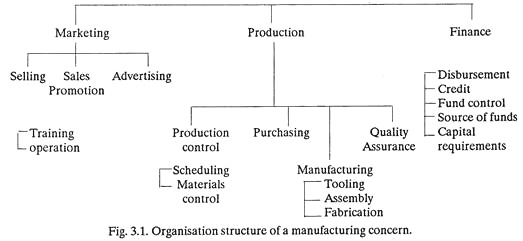After reading this article you will learn about:- 1. Concept of Organisation Structure 2. Need for Organisation Structure 3. Design.
Concept of Organisation Structure:
No organisation can work without people. Organisation structure simply means the systematic arrangement of the people working for the organization in order to achieve pre-decided goals. Organisation structure is concerned with the establishment of positions (persons) and the relationships between positions. The structure provides an appropriate framework for authority and responsibility relationships between various positions. The organisation structure is generally shown on an organisation chart.
The structure has two dimensions i.e., horizontal and vertical. The horizontal dimension defines the basic departmentation. Departmentation is the process of division of the enterprise into different parts i.e., smaller, flexible administrative units. The vertical aspects of the structure relate to the creation of a hierarchy of superiors and subordinates, leading to the establishment of a managerial structure.
Taken together, horizontal and vertical aspects set the formal structure of the organisation (Fig. 3.1). Organization has informal structure too which arises spontaneously out of the activities and interactions of people.
Need for Organisation Structure:
1. The organisation structure is designed by the management to achieve specific goals.
2. The organisation structure facilitates in fixing the responsibility department wise, section wise or on individual basis. It is necessary for timely completion of work.
3. It is necessary for the establishment of authority. It also clarifies one’s authority.
4. It helps in achieving the desired level of coordination.
ADVERTISEMENTS:
5. It promotes division of work and leads to specialisation.
6. Since organisation structure clearly defines the authority and responsibility, it avoids confusion, duplication, wastage and inefficiencies.
7. Organisation structure facilitates the flow of information and decision-making from one level to another.
8. Organisation structure defines the positions and units within the organisation.
Design of Organisation Structure:
ADVERTISEMENTS:
In designing the structure of an organisation, there are two main considerations:
1. Differentiation:
Differentiation means differences in cognitive and emotional orientations among managers in different departments and the differences in the formal structure of these departments.
2. Integration:
ADVERTISEMENTS:
Integration refers to the quality of the state of collaboration that is required to achieve unity of effort. Various departments are integral part of the whole system.
Design structure of one department may be different from that of the other, because each department is interacting with the environment in a different way.
Environments are of two types:
(i) Internal Environment:
ADVERTISEMENTS:
Everything within the organisation, including its workers, managers, working conditions and culture.
(ii) External environment:
The environment outside the organisation, for example suppliers of raw material and energy, customers, competitors, government agencies etc. The overall objective of organisational designing should be integration of activities and authority roles and relationships existing in different departments.
Steps involved in Organisation Design:
ADVERTISEMENTS:
The procedural steps involved are:
(i) Understand and formulate the objectives and goals of the organisation and the nature of business to be carried out.
(ii) Determine the functions necessary to achieve the objectives of the organisation.
(iii) Related functions e.g., Inventory Control, Production Control and Quality Control, can be grouped together.
ADVERTISEMENTS:
(iv) Examine all the functions and outline the various positions to be filled to take up those functions.
(v) Prepare job descriptions, duties and responsibilities of each position.
(vi) Fill up all the positions by recruiting suitable persons either from outside or from within by upgrading the existing personnel after giving them extensive appropriate training.
